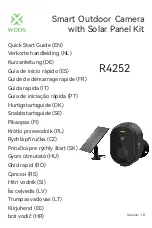
Others
109
∫
Battery
The battery is a rechargeable lithium ion
battery. Its ability to generate power is
based upon the chemical reaction that
takes place inside it. This reaction is
susceptible to the surrounding temperature
and humidity, and, if the temperature is too
high or too low, the operating time of the
battery will be shorter.
When you go out, bring charged spare
batteries.
• Prepare batteries with the charger equal
to 3 to 4 times of the power for the desired
operating time. The operating time of the
battery may become shorter in low
temperatures such as skiing resorts.
• When you travel, be sure to prepare the
supplied charger to charge the battery on
the spot.
If you drop the battery accidentally,
check to see if the battery body and
terminals are damaged.
• Inserting damaged battery in the camera
may damage the camera.
After use, be sure to remove the card
and the battery or disconnect the plug
from the electrical outlet.
• Extremely high or low temperatures will
shorten the life of the battery.
• If the battery is kept in smoky or dusty
places, the terminals may rust and cause
malfunctions.
Dispose of an unusable battery.
• The battery has a limited life.
• Do not throw the battery into fire because
it may cause an explosion.
Do not allow the battery terminals to
come in contact with metal objects
(such as necklaces, hairpins, etc.).
• This can result in a short circuit or heat
generation and, if you touch the battery in
this condition, you may be badly burned.
∫
Charger
• If you use the charger near a radio, radio
reception may be disturbed. Keep the
charger 1 m or more away from radio.
• When the charger is in use, it may
generate whirring sounds. However, this is
not a malfunction.
• After use, be sure to disconnect the AC
mains lead from the electrical outlet. (If it
is left connected, a minute amount of
current is consumed.)
• Keep the terminal of the charger and
battery clean.
∫
Condensation (When the lens or the
Viewfinder is fogged up)
When condensation has taken place:
• Turn the camera off and leave the camera
in this condition for about 2 hours. When
the camera becomes close to the ambient
temperature, the condensation
disappears naturally.
• When you move the camera from a cold
place to a hot place, put the camera into
plastic bag and then take it out after the
temperature of the camera becomes close
to the ambient temperature to avoid
condensation.
Condensation may cause a malfunction in
the camera.
Be careful to avoid condensation and take
proper measures when condensation
occurs.
FZ20-EB.book 109 ページ 2004年7月29日 木曜日 午後9時52分
Содержание LUMIX DMC-FZ20EB
Страница 9: ...Preparation 9 Lens Cap VYK0W96 Strap VFC4078 Lens Hood VYQ3234 Lens Hood Adaptor VYQ3213 ...
Страница 117: ...117 MEMO ...
Страница 118: ...118 MEMO ...
Страница 119: ...119 MEMO ...
Страница 120: ...Matsushita Electric Industrial Co Ltd Web Site http www panasonic co jp global B VQT0M48 F0704Mn0 2000A C ...












































